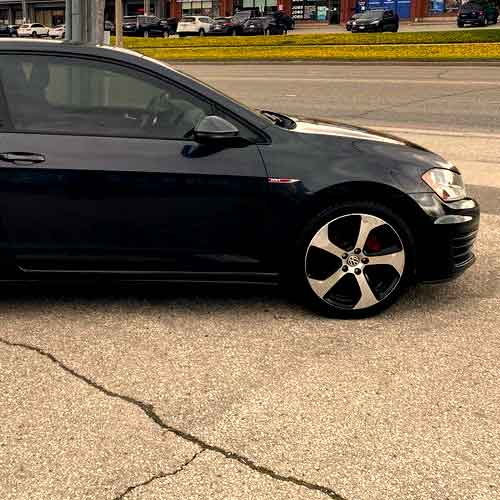Both Nokian Nordman 7 and the Hankook I PIKE showcase their unique strengths, and weaknesses, when it comes to handling snowy and icy roads. So let’s discuss things to find a better pick for your needs.

Table of Contents
Dry Traction
Dry traction depends on the tire’s overall contact with the ground and can be divided into two components: directional grip and lateral traction.
And here, the Hankook I PIKE surpasses its counterpart, with its more reliable and consistent rubber to road contact, resulting in shorter braking distances and quicker acceleration times during tests.
However, the Nokian Nordman 7 (review) tire makes a comeback when it comes to dry handling, offering greater lateral g forces.
But why is that? I mean both tires offer similar footprint from shoulders (as we measured it).
Well, this has to do with the Nokian Nordman 7 offering a lighter strcuture which offers superior steering response.
So in essense, the Hankook is better in driectional dry grip, while the Nordman 7 is superior when it comes to handling.
Snow Performance
When it comes to handling in snow, both tires demonstrate commendable performance. However, upon careful consideration, the Nokian Nordman 7 still gets a slight advantage, thanks to its wider gaps and notches, as seen on its tread.
These particular design elements are crucial as they effectively catch and hold snow, to create a snow to snow contact.
But why that matters?
Well, because, snow has a tendency to adhere better to itself rather than to rubber, so that aids in providing the tire with excellent gripping efficacy.
Moreover, the Nordman 7 tire boasts a special V-shaped lug design, which is a feature that aids in pushing snow away from the tire and propelling it forward, resulting in slightly quicker acceleration.
Conversely, the Hankook I PIKE tire performs slightly less admirably in snowy conditions due to its tread design, which includes a continuous center rib and narrower notches.
In the realm of snow performance, the clear winner is the Nokian Nordman 7 tire.
Ice Performance
In terms of ice performance, the Hankook I PIKE takes the lead, where our extensive tests have consistently shown that it outperforms the Nordman 7 tire by stopping 8.6 feet shorter, on average.
Similarly, the tire also showed superior acceleration capabilities on a average 0 to 40 mph drag test.
And both of these have to do with the tire’s unique biting edges distributed across the tread, which offer better gripping efficacy on hard packed up snow.
Conversely, the Nokian Nordman 7 tire encounters some difficulties on ice due to its wider tread gaps and fewer biting edges.
Fuel Economy
Fuel consumption is significantly influenced by factors such as the tire’s adherence to the road surface and the overall tread pattern. And considering these aspects, it easily understandable, why the Hankook I PIKE tire delivers slightly superior overall performance.
Its longitudinally aligned central rib translates to a more streamlined tread design, promoting better and straighter rolling of the tire, resulting in lower fuel consumption.
On the other hand, the Nokian Nordman 7 tire’s less “streamlined”, you can say, directional tread pattern, featuring lateral tread voids, poses more challenges for the tire, as it rolls. This leads to increased rolling resistance and subsequently higher fuel consumption.
Verdict: When it comes to fuel economy, the winner is the Nokian Nordman 7.
Wet Traction
The traction on wet surfaces is greatly influenced by two key factors: tread design and the type of rubber compound used in the tire’s tread. These factors significantly impact the tire’s (wet) grip and its resistance to hydroplaning.
In terms of grip, the Hankook I PIKE manages to get ahead, thanks to its more aggressive mix of linear and interlocking sipes.
These sipes possess the capability to absorb water more effectively, and provide exceptional wet grip, both in lateral and directional line tests.
In contrast, the Nokian Nordman 7 tire primarily relies on laterally oriented sipes, which fall short in providing comparable overall traction. Consequently, it often exhibits longer handling times, though braking efficacy is similar to its competitor.
And yes, the tire also does better in the hydroplaning resistance testing, where its lugs are more efficient in providing faster float speeds on both curved and stragith aqua tests.
Comfort Levels
Tire comfort is primarily determined by factors such as road noise generation and vibration absorption capabilities. These attributes can vary based on the tire’s construction, materials used, tread design, and sidewall configuration.
In this regard, both tires offer remarkably similar performances. They provide a supremely smooth ride and excel in cushioning against road bumps.
Moreover, both tires exhibit comparable noise reduction abilities, which is significant as noise primarily stems from air particles colliding with the tire’s tread walls.
Verdict: In terms of comfort levels, both tires are equally impressive, making it a tie between them.
Verdict?
After conducting a thorough comparison of these two exceptional winter tires, it is clear that each tire possesses unique strengths.
The Nokian Nordman 7 tire excels in deep snow conditions, thanks to its wider tread voids, notches, and V-shaped lugs, which ensure superior snow displacement. Furthermore, it demonstrates impressive lateral traction on dry roads.
The Hankook I PIKE tire, on the other hand, showcases superior traction capabilities on icy terrain, owing to its abundance of biting edges and varied incisions. Additionally, it offers better braking and handling efficiency on wet roads and slightly outperforms in terms of fuel economy.
In terms of comfort, both tires provide equally outstanding performances.
Considering all factors, it is evident that both the Nokian Nordman 7 and Hankook I PIKE tires have their respective strengths and excel in different areas.